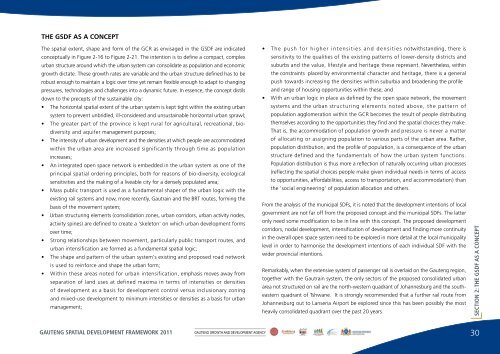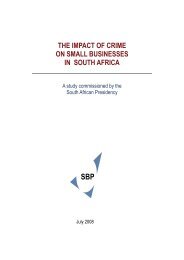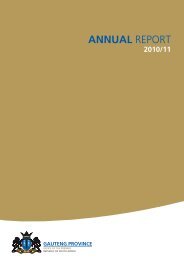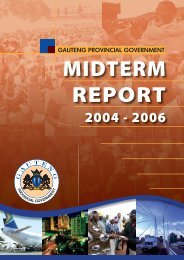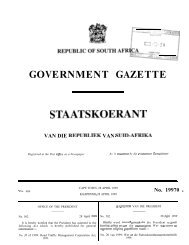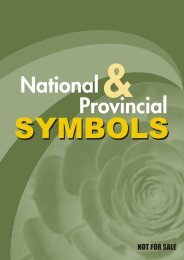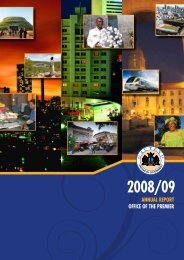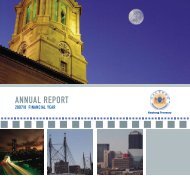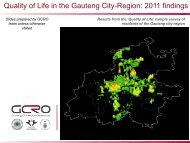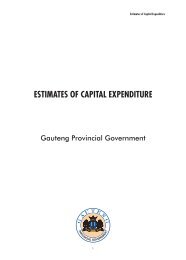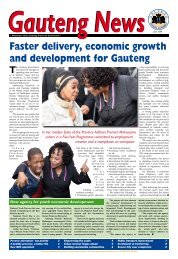the gauteng spatial development framework - Gauteng Online
the gauteng spatial development framework - Gauteng Online
the gauteng spatial development framework - Gauteng Online
You also want an ePaper? Increase the reach of your titles
YUMPU automatically turns print PDFs into web optimized ePapers that Google loves.
THE GSDF AS A CONCEPTThe <strong>spatial</strong> extent, shape and form of <strong>the</strong> GCR as envisaged in <strong>the</strong> GSDF are indicatedconceptually in Figure 2-16 to Figure 2-21. The intention is to define a compact, complexurban structure around which <strong>the</strong> urban system can consolidate as population and economicgrowth dictate. These growth rates are variable and <strong>the</strong> urban structure defined has to berobust enough to maintain a logic over time yet remain flexible enough to adapt to changingpressures, technologies and challenges into a dynamic future. In essence, <strong>the</strong> concept distilsdown to <strong>the</strong> precepts of <strong>the</strong> sustainable city:• The horizontal <strong>spatial</strong> extent of <strong>the</strong> urban system is kept tight within <strong>the</strong> existing urbansystem to prevent unbridled, ill-considered and unsustainable horizontal urban sprawl;• The greater part of <strong>the</strong> province is kept rural for agricultural, recreational, biodiversityand aquifer management purposes;• The intensity of urban <strong>development</strong> and <strong>the</strong> densities at which people are accommodatedwithin <strong>the</strong> urban area are increased significantly through time as populationincreases;• An integrated open space network is embedded in <strong>the</strong> urban system as one of <strong>the</strong>principal <strong>spatial</strong> ordering principles, both for reasons of bio-diversity, ecologicalsensitivities and <strong>the</strong> making of a liveable city for a densely populated area;• Mass public transport is used as a fundamental shaper of <strong>the</strong> urban logic with <strong>the</strong>existing rail systems and now, more recently, Gautrain and <strong>the</strong> BRT routes, forming <strong>the</strong>basis of <strong>the</strong> movement system;• Urban structuring elements (consolidation zones, urban corridors, urban activity nodes,activity spines) are defined to create a 'skeleton' on which urban <strong>development</strong> formsover time;• Strong relationships between movement, particularly public transport routes, andurban intensification are formed as a fundamental <strong>spatial</strong> logic;• The shape and pattern of <strong>the</strong> urban system's existing and proposed road networkis used to reinforce and shape <strong>the</strong> urban form;• Within <strong>the</strong>se areas noted for urban intensification, emphasis moves away fromseparation of land uses at defined maxima in terms of intensities or densitiesof <strong>development</strong> as a basis for <strong>development</strong> control versus inclusionary zoningand mixed-use <strong>development</strong> to minimum intensities or densities as a basis for urbanmanagement;• The push for higher intensities and densities notwithstanding, <strong>the</strong>re issensitivity to <strong>the</strong> qualities of <strong>the</strong> existing patterns of lower-density districts andsuburbs and <strong>the</strong> value, lifestyle and heritage <strong>the</strong>se represent. Never<strong>the</strong>less, within<strong>the</strong> constraints placed by environmental character and heritage, <strong>the</strong>re is a generalpush towards increasing <strong>the</strong> densities within suburbia and broadening <strong>the</strong> profileand range of housing opportunities within <strong>the</strong>se; and• With an urban logic in place as defined by <strong>the</strong> open space network, <strong>the</strong> movementsystems and <strong>the</strong> urban structuring elements noted above, <strong>the</strong> pattern ofpopulation agglomeration within <strong>the</strong> GCR becomes <strong>the</strong> result of people distributing<strong>the</strong>mselves according to <strong>the</strong> opportunities <strong>the</strong>y find and <strong>the</strong> <strong>spatial</strong> choices <strong>the</strong>y make.That is, <strong>the</strong> accommodation of population growth and pressure is never a matterof allocating or assigning population to various parts of <strong>the</strong> urban area. Ra<strong>the</strong>r,population distribution, and <strong>the</strong> profile of population, is a consequence of <strong>the</strong> urbanstructure defined and <strong>the</strong> fundamentals of how <strong>the</strong> urban system functions.Population distribution is thus more a reflection of naturally occurring urban processes(reflecting <strong>the</strong> <strong>spatial</strong> choices people make given individual needs in terms of accessto opportunities, affordabilities, access to transportation, and accommodation) than<strong>the</strong> 'social engineering' of population allocation and o<strong>the</strong>rs.From <strong>the</strong> analysis of <strong>the</strong> municipal SDFs, it is noted that <strong>the</strong> <strong>development</strong> intentions of localgovernment are not far off from <strong>the</strong> proposed concept and <strong>the</strong> municipal SDFs. The latteronly need some modification to be in line with this concept. The proposed <strong>development</strong>corridors, nodal <strong>development</strong>, intensification of <strong>development</strong> and finding more continuityin <strong>the</strong> overall open space system need to be explored in more detail at <strong>the</strong> local municipalitylevel in order to harmonise <strong>the</strong> <strong>development</strong> intentions of each individual SDF with <strong>the</strong>wider provincial intentions.Remarkably, when <strong>the</strong> extensive system of passenger rail is overlaid on <strong>the</strong> <strong>Gauteng</strong> region,toge<strong>the</strong>r with <strong>the</strong> Gautrain system, <strong>the</strong> only sectors of <strong>the</strong> proposed consolidated urbanarea not structured on rail are <strong>the</strong> north-western quadrant of Johannesburg and <strong>the</strong> sou<strong>the</strong>asternquadrant of Tshwane. It is strongly recommended that a fur<strong>the</strong>r rail route fromJohannesburg out to Lanseria Airport be explored since this has been possibly <strong>the</strong> mos<strong>the</strong>avily consolidated quadrant over <strong>the</strong> past 20 years.SECTION 2: THE GSDF AS A CONCEPTGAUTENG SPATIAL DEVELOPMENT FRAMEWORK 2011GAUTENG GROWTH AND DEVELOPMENT AGENCY30


